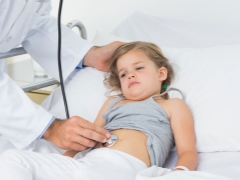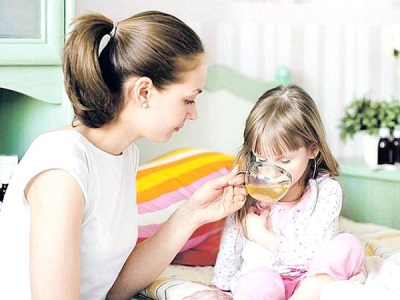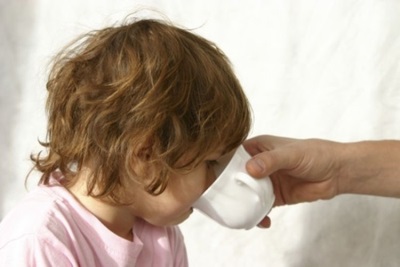Vomiting and abdominal pain in a child
The combination of bouts of vomiting with pain in the abdomen is perceived by parents quite alarming, as it often indicates the disease in a child. When can a child have a stomach ache and start vomiting and how should parents act?
How does it manifest itself?
The child begins to contract the muscles of the stomach, as well as the muscles of the abdominal wall, which provokes the elimination of the entire contents of the stomach through the mouth. Usually, before this, the child feels nauseous, he is anxious, turns pale, the skin of his limbs becomes cool.
The pressure with which the contents of the stomach is ejected can be very strong. The masses allocated to the kid are in most cases simply represented by undigested food, but quite often they may have impurities and an unpleasant smell.
The more often there is a vomiting attack, the more weak the baby will become. With repeated vomiting, as well as in the case of attachment to it of high temperature and diluted stool, the risks of dehydration increase.
Abdominal pain, appearing simultaneously with attacks of vomiting, are dull, cramping, acute, aching, cutting, varying severity and duration. Most often, the child shows the navel when asked to indicate where it hurts. Also painful sensations can appear in the upper part of the right and in other places.

Symptoms and possible causes, what to do?
Abdominal pain, occurring simultaneously with episodes of vomiting, are both manifestations of functional disorders of the digestive system, and symptoms of serious diseases.
Consider the possible causes of the combination of these symptoms in more detail:
Cause | How manifest | What should be done |
Severe pain in the abdomen, refusal to eat, worsened general condition of the child, non-relieving attacks of vomiting, pale skin, apathetic behavior, slight fever (high temperature is observed only in very young children). | Immediately call an ambulance, as this surgical pathology requires immediate hospital treatment. | |
Poisoning | Convulsive severe pains in the navel or on the left side of the abdomen, multiple vomiting, discharge of loose stools, fever, pallor. | Immediately after the onset of symptoms of poisoning, seek qualified help, but until the doctors have arrived, give the child the means to rehydrate. |
Intestinal infection | Many episodes of vomiting, fever, restless behavior, decreased appetite, abdominal pain, diarrhea. | Call the doctor and, before his visit, begin to unsolder the baby using anti-dehydration agents |
Pains that are localized in the lower abdomen, periodic vomiting, the appearance of a bulge in the groin area. | Contact a pediatric surgeon to clarify the diagnosis and carry out the necessary treatment. | |
Acetonemic syndrome | Repeated episodes of vomiting, fever, painful sensations in the abdomen, a specific smell from the child exhaled air and urine, which the baby releases. | Contact a pediatrician for help and give your child glucose preparations. |
Food Intolerance | The appearance of abdominal pain, rash on the skin, loose stools, bouts of vomiting. | Refer to the pediatrician and exclude the product, the use of which provoked such a clinical picture. |
Cholecystitis | Increased temperature, severe pain in the right hypochondrium, vomiting of undigested food with admixture of bile. | Call an ambulance and clarify the diagnosis, as this is a dangerous disease for the health of the baby. |
Intestinal obstruction | Dull abdominal pains, sudden strong bouts of vomiting of undigested food, restless behavior of the child, discharge of feces with blood (they resemble currant jelly in appearance). | Immediately call an ambulance, as this disease is a serious threat to the life of the baby. |
The appearance of abdominal pain after eating disorders (it is often localized in the upper right), a single vomiting, after which the condition improves. | Refer to the gastroenterologist with the child and follow the treatment prescribed by him. | |
Peptic ulcer | Constant abdominal pain, which becomes stronger after eating, vomiting with the detection of blood impurities. | Show the child to a gastroenterologist and follow his instructions for faster recovery. |
Cyclic vomiting syndrome | Sudden episodes of vomiting and abdominal pain, while the child looks healthy and the symptoms go away without treatment. | Show the child to the pediatrician to make sure that there are no other causes of pain and vomiting. |
Do I need to immediately call a doctor?
Both vomiting and abdominal pain can be signs of dangerous diseases, so it is worthwhile to show the child to the doctor in order to determine the cause of these symptoms. Indications for an immediate call to an ambulance should be such situations:
- The child has indomitable vomiting.
- The condition of the baby has greatly deteriorated.
- Vomiting and pain were provoked by the use of toxic substances or spoiled food.
- I can not get a child to drink.
- The baby began to dehydrate.
- Blood in the vomit spotted.
- The child is missing a chair.
- Diarrhea and fever joined vomiting and pain.
First aid policy
Immediately after calling the doctor should:
- To wash the child and rinse the crumbs of the mouth with clean water.
- Lay the child so that his head is turned to the side or slightly raised (you can put a pillow).
- Start drinking in small portions.
You should not self-flush the baby's stomach, give the crumbs any medication, apply something hot or cold to the stomach, and also feed the child (except infants).
Treatment
Since vomiting, combined with pain in the abdomen, can be a sign of various diseases, self-treatment is unacceptable. Only a doctor should prescribe any medications to a child with such symptoms.
If the cause of such a clinical picture is one of the surgical pathologies, the child will be sent to the emergency room at the surgical hospital and will decide the issue with the operation. The gastroenterologist will be engaged in the treatment of gastritis and peptic ulcer. In case of an intestinal infection, the doctor will prescribe antibiotics to the baby (if necessary), sorbents, probiotics and other medicines, based on the situation, diagnosis and severity of the child’s condition.
When poisoning and infection of the gastrointestinal tract plays a big role enough to drink for your baby. The child is given salt solutions, non-carbonated mineral water, dogrose broth, dried fruit compote. About, what can be given to children with vomitingread in another article.
How to understand that treatment helps?
You will notice that the baby’s condition begins to improve when the seizures of vomiting stop and the pain in the abdomen disappears. The child will gradually become more active, his appetite and good mood will return.
Tips for parents
- For otpaivaniya child is best to use special solutions that should be in the first-aid kit in every house where there is a small child. If there are no such drugs at hand, you can prepare a saline solution yourself, by mixing in warm water (in one liter) sugar (eight teaspoons) and salt (you need a tea spoon). You can also add a quarter of a spoon of soda, and sugar to replace with honey, if the child does not have allergic reactions to this product.
- While waiting for the doctor, neither anesthetics, nor antiemetic or antispasmodic should be given. If pain and vomiting are caused by a surgical pathology, such medicines will prevent the patient from diagnosing the disease on time and can cost the child life.
- If the cause of vomiting and pain was poisoning or an intestinal infection, as soon as the child's condition begins to improve and the baby asks for food, give him some warm, liquid food that will not irritate the stomach. Such food can be liquid rice porridge, slimy soup, jelly. The child’s menu should be expanded carefully, increasing portions of dishes and adding new foods within 5-10 days from the onset of the disease.











